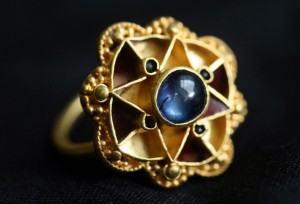 Metal detectorist Michael Greenhorn discovered a gold and sapphire ring in a field six miles south of York in April of 2009. He reported it to the Portable Antiquities Scheme and, as expected, it was declared treasure. The Yorkshire Museum has just raised the £35,000 assessed value to buy the ring so it can be kept where it was discovered, studied thoroughly and put on display.
Metal detectorist Michael Greenhorn discovered a gold and sapphire ring in a field six miles south of York in April of 2009. He reported it to the Portable Antiquities Scheme and, as expected, it was declared treasure. The Yorkshire Museum has just raised the £35,000 assessed value to buy the ring so it can be kept where it was discovered, studied thoroughly and put on display.
Sapphire jewelry is rare in medieval England. Sapphires were reserved for royalty, upper nobility or high-ranking clergy and were said to hold magical protective powers, especially against poison. The York ring is the second earliest example of sapphire jewelry known in England. The oldest sapphire jewel is a Roman example from the fifth century. The York ring was made after that, but scholars aren’t sure exactly when. There is literally nothing comparable to help them determine when it was made.
The ring weighs 10.2 grams, is 2.5 centimeters in diameter. A 6 millimeter deep blue sapphire is mounted in the middle, with pieces of red glass inset around it. The edges are adorned with fine gold beading, and all the gold in the piece is of a very high standard, an alloy of 90% gold, 8% silver and 2% copper.
The gold beading is characteristic of the Viking period (10th – 11th centuries), but a combination of red and blue glass set in gold is characteristic of early Anglian jewelry (7th – 9th centuries). The sapphire could have been used to replace the blue glass of the more modest traditional Anglian design to create a ring for fit for an important figure, maybe even a king. The only other known sapphire around this period was in Edward the Confessor’s coronation ring (he was crowned in 1042), and is now in the Imperial State Crown of Great Britain (it’s at the center of the Maltese Cross on the top of the crown). That sapphire is the oldest gemstone in the Crown Jewels.
The museum will launch a multi-disciplinary investigation to find out more about the ring. They will try to narrow down the date, comparing it stylistically to other medieval jewelry. They’re also going to focus on the high quality of the gold alloy, hoping the composition might shed some light on what historians think may have been a high level jewelry-making industry in medieval York.
The museum, in York, also plans to track down the ultimate origin of the sapphire itself. It’s possible that it came originally from India or Sri Lanka and a special scanning electron microscopy examination of the gem will almost certainly be carried out to identify trace elements and ascertain its geological background.
This may also help to reconstruct its pre-Anglo-Saxon history. Is it likely to have been imported into England or Europe from thousands of miles away in Anglo-Saxon times, or is it more likely that it was imported in Roman times and re-used in various different high status roles for hundreds of years before it was lost south of York a millennium or more ago.
Microscopic examination of ware [sic] marks on the ring may also shed light on its history – as might a detailed historical examination of the area around where it was found
The ring is scheduled to go on display at the Yorkshire Museum in the next few weeks.
>>The oldest sapphire jewel is a Roman example from the fifth century Roman.<<
From the 5th c Roman what?
Jewelry mystery. Awesome.
interesting piece of jewelry. almost Egyptian like
I am a jewelry scientist and I am very fascinated by this medieval sapphire ring. Thank you for sharing. Medieval jewelry is my biggest passion! Best, Selina